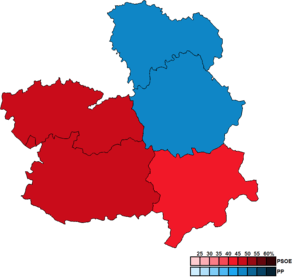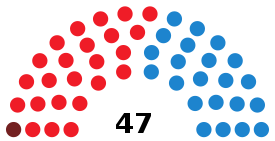1995 Castilian-Manchegan regional election
The 1995 Castilian-Manchegan regional election was held on Sunday, 28 May 1995, to elect the 4th Cortes of the autonomous community of Castilla–La Mancha. All 47 seats in the Cortes were up for election. The election was held simultaneously with regional elections in twelve other autonomous communities and local elections all throughout Spain.
| |||||||||||||||||||||||||||||||||||||||||||||
All 47 seats in the Cortes of Castilla–La Mancha 24 seats needed for a majority | |||||||||||||||||||||||||||||||||||||||||||||
|---|---|---|---|---|---|---|---|---|---|---|---|---|---|---|---|---|---|---|---|---|---|---|---|---|---|---|---|---|---|---|---|---|---|---|---|---|---|---|---|---|---|---|---|---|---|
| Opinion polls | |||||||||||||||||||||||||||||||||||||||||||||
| Registered | 1,352,958 | ||||||||||||||||||||||||||||||||||||||||||||
| Turnout | 1,066,571 (78.8%) | ||||||||||||||||||||||||||||||||||||||||||||
| |||||||||||||||||||||||||||||||||||||||||||||
 Constituency results map for the Cortes of Castilla–La Mancha | |||||||||||||||||||||||||||||||||||||||||||||
| |||||||||||||||||||||||||||||||||||||||||||||
Despite bearing enormous losses, the Spanish Socialist Workers' Party (PSOE) was able to maintain government, albeit with a mere 1-seat majority. The People's Party (PP), which in this election made the greatest gains, finished a close second but remained unable to win the PSOE in one of its — considered — strongest strongholds. Meanwhile, United Left (IU) maintained its presence in the Courts and was able to increase both its vote support and share, but remained unable to gain new seats.
Overview
Electoral system
The Cortes of Castilla–La Mancha were the devolved, unicameral legislature of the autonomous community of Castilla–La Mancha, having legislative power in regional matters as defined by the Spanish Constitution and the Castilian-Manchegan Statute of Autonomy, as well as the ability to vote confidence in or withdraw it from a President of the Junta of Communities.[1] Voting for the Cortes was on the basis of universal suffrage, which comprised all nationals over eighteen, registered in Castilla–La Mancha and in full enjoyment of their political rights.
The 47 members of the Cortes of Castilla–La Mancha were elected using the D'Hondt method and a closed list proportional representation, with a threshold of 3 percent of valid votes—which included blank ballots—being applied in each constituency. Parties not reaching the threshold were not taken into consideration for seat distribution. Additionally, the use of the D'Hondt method might result in an effective threshold over three percent, depending on the district magnitude.[2] Seats were allocated to constituencies, corresponding to the provinces of Albacete, Ciudad Real, Cuenca, Guadalajara and Toledo. Each constituency was entitled to an initial minimum of five seats, with the remaining 22 allocated among the constituencies in proportion to their populations.[1][3]
The electoral law provided that parties, federations, coalitions and groupings of electors were allowed to present lists of candidates. However, groupings of electors were required to secure the signature of at least 1 percent of the electors registered in the constituency for which they sought election. Electors were barred from signing for more than one list of candidates. Concurrently, parties and federations intending to enter in coalition to take part jointly at an election were required to inform the relevant Electoral Commission within ten days of the election being called.[3][4][5]
Election date
The term of the Cortes of Castilla–La Mancha expired four years after the date of their previous election. Elections to the Cortes were fixed for the fourth Sunday of May every four years. The previous election was held on 26 May 1991, setting the election date for the Cortes on Sunday, 28 May 1995.[1][3][4][5]
The Cortes of Castilla–La Mancha could not be dissolved before the date of expiry of parliament. In the event of an investiture process failing to elect a regional President within a two-month period from the first ballot, the candidate from the party with the highest number of seats was to be deemed automatically elected.[1]
Opinion polls
The table below lists voting intention estimates in reverse chronological order, showing the most recent first and using the dates when the survey fieldwork was done, as opposed to the date of publication. Where the fieldwork dates are unknown, the date of publication is given instead. The highest percentage figure in each polling survey is displayed with its background shaded in the leading party's colour. If a tie ensues, this is applied to the figures with the highest percentages. The "Lead" column on the right shows the percentage-point difference between the parties with the highest percentages in a given poll. When available, seat projections are also displayed below the voting estimates in a smaller font. 24 seats were required for an absolute majority in the Cortes of Castilla–La Mancha.
- Color key:
Exit poll
| Polling firm/Commissioner | Fieldwork date | Sample size | Turnout | Lead | |||
|---|---|---|---|---|---|---|---|
| 1995 regional election | 28 May 1995 | N/A | 78.8 | 45.7 24 |
44.3 22 |
7.6 1 |
1.4 |
| Eco Consulting/RTVE[p 1] | 28 May 1995 | ? | ? | 43.2 21/22 |
44.2 22/24 |
8.6 2/4 |
1.0 |
| Vox Pública–ODEC/Antena 3[p 1] | 28 May 1995 | ? | ? | ? 19/22 |
? 24/25 |
? 1/3 |
? |
| Demoscopia/El País[p 2][p 3][p 4][p 5] | 10–15 May 1995 | 1,000 | ? | 41.9 20/23 |
47.0 23/25 |
8.6 2/4 |
5.1 |
| CIS[p 6][p 7] | 24 Apr–10 May 1995 | 1,696 | 75.1 | 44.2 | 45.3 | 8.7 | 1.1 |
| Gruppo/ABC[p 8] | 24–27 Sep 1994 | 1,000 | ? | 36.8 16/19 |
47.8 24/27 |
11.2 4 |
11.0 |
| 1994 EP election | 12 Jun 1994 | N/A | 65.5 | 37.9 18 |
47.9 25 |
10.5 4 |
10.0 |
| Gruppo/ABC[p 9] | 10–11 May 1994 | 1,000 | ? | 39.2 18/21 |
46.6 23/25 |
10.6 3/4 |
7.4 |
| Sigma Dos/ABC[p 10] | 28–31 Jan 1994 | 1,000 | ? | 42.4 21/22 |
44.8 22/23 |
9.2 2/4 |
2.4 |
| 1993 general election | 6 Jun 1993 | N/A | 82.1 | 45.3 24 |
43.0 22 |
7.6 1 |
2.3 |
| 1991 regional election | 26 May 1991 | N/A | 72.5 | 52.2 27 |
35.9 19 |
6.2 1 |
16.3 |
Results
Overall
 | ||||||
| Parties and coalitions | Popular vote | Seats | ||||
|---|---|---|---|---|---|---|
| Votes | % | ±pp | Total | +/− | ||
| Spanish Socialist Workers' Party (PSOE) | 483,888 | 45.70 | –6.47 | 24 | –3 | |
| People's Party (PP) | 469,127 | 44.30 | +8.45 | 22 | +3 | |
| United Left–Left of Castilla–La Mancha (IU–ICAM) | 80,482 | 7.60 | +1.43 | 1 | ±0 | |
| Centrist Union (UC) | 4,288 | 0.40 | –3.09 | 0 | ±0 | |
| Regionalist Party of Castilla–La Mancha (PRCM) | 3,121 | 0.29 | +0.19 | 0 | ±0 | |
| Action for Talavera Region (ACTAL) | 2,015 | 0.19 | –0.07 | 0 | ±0 | |
| The Greens–Green Group (LV–GV) | 1,474 | 0.14 | New | 0 | ±0 | |
| Commoners' Land–Castilian Nationalist Party (TC–PNC) | 1,406 | 0.13 | +0.03 | 0 | ±0 | |
| Regionalist Party of Guadalajara (PRGU) | 543 | 0.05 | –0.03 | 0 | ±0 | |
| Guadalajara Independent Union (UIG) | 513 | 0.05 | New | 0 | ±0 | |
| Spanish Phalanx of the CNSO (FE–JONS) | 498 | 0.05 | New | 0 | ±0 | |
| Independent Regional Unity (URI) | 391 | 0.04 | New | 0 | ±0 | |
| Blank ballots | 11,128 | 1.05 | +0.06 | |||
| Total | 1,058,874 | 47 | ±0 | |||
| Valid votes | 1,058,874 | 99.28 | +0.04 | |||
| Invalid votes | 7,697 | 0.72 | –0.04 | |||
| Votes cast / turnout | 1,066,571 | 78.83 | +6.33 | |||
| Abstentions | 286,387 | 21.17 | –6.33 | |||
| Registered voters | 1,352,958 | |||||
| Sources[6][7][8] | ||||||
Aftermath
| Investiture José Bono (PSOE) | ||
| Ballot → | 30 June 1995 | |
|---|---|---|
| Required majority → | 24 out of 47 | |
Yes
|
24 / 47 | |
23 / 47 | ||
| Abstentions | 0 / 47 | |
| Absentees | 0 / 47 | |
| Sources[8] | ||
References
- Opinion poll sources
- "El PP se impuso en diez comunidades". Diario de Navarra (in Spanish). 29 May 1995.
- "El PP será la fuerza más votada en 12 comunidades". El País (in Spanish). 20 May 1995.
- "El tirón de Bono mantiene la incógnita". El País (in Spanish). 20 May 1995.
- "Mañana, previsiones para las municipales". El País (in Spanish). 20 May 1995.
- "El PP gana en doce autonomías y el PSOE sólo en Extremadura, según un sondeo". La Vanguardia (in Spanish). 21 May 1995.
- "Preelectoral Comunidad Autónoma de Castilla–La Mancha (Estudio 2165. Abril-Mayo 1995)". CIS (in Spanish). 10 May 1995.
- "Estudio CIS nº 2165. Ficha técnica" (PDF). CIS (in Spanish). 10 May 1995.
- "El PP ganaría hoy en Castilla–La Mancha por mayoría absoluta". ABC (in Spanish). 30 October 1994.
- "El PP rozaría la mayoría absoluta en Castilla–La Mancha, según una encuesta de Gruppo para ABC". ABC (in Spanish). 22 May 1994.
- "El PSOE perdería hoy la mayoría en Castilla–La Mancha, según una encuesta de Sigma 2 para ABC". ABC (in Spanish). 27 February 1994.
- Other
- "Statute of Autonomy of Castilla–La Mancha of 1982". Organic Law No. 9 of 10 August 1982. Official State Gazette (in Spanish). Retrieved 15 September 2017.
- Gallagher, Michael (30 July 2012). "Effective threshold in electoral systems". Trinity College, Dublin. Archived from the original on 30 July 2017. Retrieved 22 July 2017.
- "Castilla–La Mancha Electoral Law of 1986". Law No. 5 of 23 December 1986. Official Journal of Castilla–La Mancha (in Spanish). Retrieved 15 September 2017.
- "General Electoral System Organic Law of 1985". Organic Law No. 5 of 19 June 1985. Official State Gazette (in Spanish). Retrieved 28 December 2016.
- "Representation of the people Institutional Act". www.juntaelectoralcentral.es. Central Electoral Commission. Retrieved 16 June 2017.
- "Cortes of Castilla–La Mancha election results, 28 May 1995" (PDF). www.juntaelectoralcentral.es (in Spanish). Electoral Commission of Castilla–La Mancha. 16 June 1995. Retrieved 29 September 2017.
- "IV Legislature. Regional election, 28 May 1995". www.cortesclm.es (in Spanish). Cortes of Castilla–La Mancha. Retrieved 29 September 2017.
- "Cortes of Castilla–La Mancha elections since 1983". historiaelectoral.com (in Spanish). Electoral History. Retrieved 29 September 2017.
.jpg)
